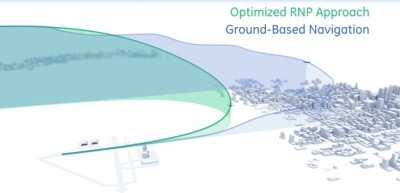GE Aviation Helps Airways New Zealand Redesign Airspace For
Projected Growth
 Performance-Based Navigation (PBN) Services will assist
Airways New Zealand in a redesign of the Queenstown airspace that
will accommodate expected traffic growth of 40% at the Queenstown
airport over the next five years. New PBN arrival and departure
paths will improve both air traffic flow and access to all
operators.
Performance-Based Navigation (PBN) Services will assist
Airways New Zealand in a redesign of the Queenstown airspace that
will accommodate expected traffic growth of 40% at the Queenstown
airport over the next five years. New PBN arrival and departure
paths will improve both air traffic flow and access to all
operators.
Using Required Navigation Performance technology (RNP), GE
Aviation, in conjunction with Airways New Zealand, will redesign,
validate and deploy approach and departure procedures for runways
23 and 05. RNP paths will be individually optimized for each
participating airline in order to maximize fuel savings and
reductions of CO2. Airways New Zealand will redesign conventional
procedures to better accommodate non-RNP traffic. Together, the
integrated paths will enable a more streamlined air traffic
management process at Queenstown.
A key benefit of PBN paths is the opportunity to continuously
improve deployed paths. Because PBN doesn’t rely on static,
ground-based navigation aids, there is flexibility to redesign the
PBN paths initially deployed at Queenstown to accommodate changing
airspace needs.

The airport, known for its complicated approach through the
snow-covered mountains of New Zealand's Southern Alps, accommodates
a variety of aircraft on any given day – from airline jets
and turboprops, to tour operators and helicopters and even gliders.
The airspace redesign will allow Airways New Zealand to
significantly increase capacity - from five operations per hour to
12 or more- while lessening the complexity of air traffic
management for controllers. Furthermore, New Zealand’s
aviation regulatory body, CAA New Zealand, recommends that all
scheduled jet operations be conducted using the RNP procedures, and
believes the safety case has already been made1. By harmonizing the
new RNP paths with other paths, Queenstown air traffic control
staff will be able to focus on the key task of separating and
segregating inbound and ground traffic in a non-radar
environment.
“Airways New Zealand has been an advocate for RNP in
Queenstown since GE-designed paths were first deployed there in
2004,” said Giovanni Spitale, general manager for GE’s
PBN Services. “Our team is pleased to work with the
progressive people at Airways New Zealand to continue improving
airline operations into the region and overall airspace management
for the Queenstown air traffic controllers.”
Queenstown was one of the first success stories showcasing the
benefits RNP implementation can yield at a terrain-challenged
airport. Since the first GE-designed RNP paths were deployed there
for Qantas in 2004, two other airlines have begun RNP operations at
Queenstown to improve schedule reliability and access. “The
implementation of a PBN-based ATM plan was a natural progression to
our airspace modernization efforts,” said Airways New
Zealand’s General Manager ANS, Lew Jenkins. “We have
seen first-hand the immense benefits an RNP program produces for
both jet operators and ATC. We are looking forward to implementing
this project so all operators in our airspace can benefit from the
RNP paths.”

Initial RNP tracks were primarily implemented at Queenstown to
serve as a mechanism for one aircraft to maneuver through the
mountainous terrain on a reliable, repeatable flight path. With
this next evolution of paths, Airways New Zealand and GE are
working together to solve the capacity constraints while
maintaining the benefits of RNP already realized at the
airport.
RNP procedures, an advanced form of PBN, can be deployed at any
airport, allowing aircraft to fly very precise paths with an
accuracy of less than a wingspan. This precision allows pilots to
land the aircraft in weather conditions that would otherwise
require them to hold, divert to another airport, or even cancel the
flight before departure. In addition, since the procedures are very
precise, they can be designed to shorten the distance an aircraft
has to fly en-route, and to reduce fuel burn, exhaust emissions and
noise pollution in communities near airports. Because of
RNP’s precision and reliability, the technology can help air
traffic controllers reduce flight delays and alleviate air traffic
congestion.
 ANN's Daily Aero-Term (04.25.24): Airport Rotating Beacon
ANN's Daily Aero-Term (04.25.24): Airport Rotating Beacon ANN's Daily Aero-Linx (04.25.24)
ANN's Daily Aero-Linx (04.25.24) Klyde Morris (04.22.24)
Klyde Morris (04.22.24) Airborne 04.24.24: INTEGRAL E, Elixir USA, M700 RVSM
Airborne 04.24.24: INTEGRAL E, Elixir USA, M700 RVSM Airborne 04.22.24: Rotor X Worsens, Airport Fees 4 FNB?, USMC Drone Pilot
Airborne 04.22.24: Rotor X Worsens, Airport Fees 4 FNB?, USMC Drone Pilot





